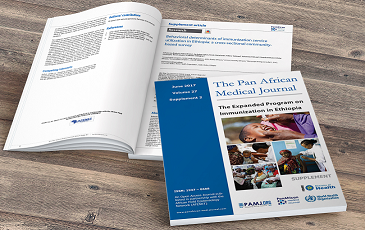Large twisted ovarian fibroma in menopausal women: a case report
Majdouline Boujoual1,&, Ihsan Hakimi2, Jaouad Kouach2, Mohamed Oukabli3, Driss Rahali Moussaoui2, Mohammed Dehayni2
1Department of Gynecology-Obstetric, University of Medicine Tangier, Military Training Hospital Med V, Rabat, Morocco, 2Department of Gynecology-Obstetric, Military Training Hospital Med V, Rabat, Morocco, 3Department of Pathology, Military Training Hospital Med V, Rabat, Morocco
&Corresponding author
Majdouline Boujoual, Department of Gynecology-Obstetric, University of Medicine Tangier, Military, Training Hospital Med V, Rabat, Morocco
Ovarian fibroma is the most common benign solid tumors of the ovary, commonly misdiagnosed as uterine fibromaor as malignant ovarian tumors. It occurs generally in older perimenopausal and postmenopausal women. Occasionally large fibromas may undergo torsion causing acute abdominal pain. Doppler Ultrasonographyimaging is the choice study. CT and MRI are often needed for further characterization and differentiation from other solid ovarian masses. The choice treatment is surgical removal with intraoperative frozensection. Immunohistochemicalanalysis is recommended to rule out the differential diagnosis. Here we present a case of a postmenopausal woman with a large twisted ovarian fibroma reflecting diagnostic and management difficulties including potential misdiagnosis of the tumor as a malignant ovarian neoplasm that may influence the surgical approach.
Ovarian fibromas are the most common benign solid tumors of the ovary (1-4%), typically detected in middle aged women [1], often difficult to diagnose preoperatively and commonly misdiagnosed as uterine fibromas, because of their same pathology, complications, clinical and ultrasonic features [2,3], or sometimes as malignant ovarian tumors because of accompanying ascites and increased serum CA-125 level [4]. Extra uterine fibromas present greater diagnostic challenge. Here we present a case of a 62 year-old postmenopausal with a large twisted ovarian fibroma presented as acute pelvic pain. This case highlights the diagnostic difficulties that may be encountered in the management of twisted ovarian fibroma including potential misdiagnosis of the tumor as a malignant ovarian neoplasm that may influence the surgical approach.
A 62-year-old post-menopausal,multiparous woman waspresented in emergency with nausea; vomiting and a 6-day history of worsening abdominal pain started in the right lower quadrant and subsequently spread to the whole abdomen. In her past medical history wereintermittent episodes of abdominal discomfort and a sensation of abdominal heaviness during the preceding months. Her vital signs were all within normal limits. Physical examination revealed a palpable abdominal mass in the lower abdomen with sensibility and involuntary guarding. Vaginal examination revealed a normal sized uterus and a large painful irregular mass of 10 cm size, firm in consistency. Pelvic ultrasonography showed a non-homogeneous mass (120 × 10 mm) in the upper and right latero uterinewithout any flow on color Doppler.Pelvic computed tomography revealed a right enlarged ovary with heterogeneous iso-dense mass in the midline, rotated toward the contralateral side of the pelvis measuring 122× 86cm with deviation of the uterus without lymphadenopathy or pelvic effusion (Figure 1, Figure 2). Anexploratory laparotomy had showed a black bluish encapsulated mass arising from the twisted right adnexa, measuring 140x100x60 mm with irregular surface and hemorrhagicreshuffle, attached to the right ovary with a thrice twisted pedicle (Figure 3, Figure 4, Figure 5). Both the uterus and left adnexa appeared normal. A total hysterectomy and bilateral salpingo-ooferectomy were performed. According to pathological and immunohistochimical findings, the diagnosis of ovarian fibroma with extensive ischemic necrosis was confirmed (Figure 6, Figure 7).
Mesenchymal neoplasms of the ovary are uncommon, not specific and determine difficult problems in diagnosis, histogenesis, behavior, and therapy [5]. Ovarian fibroma is seen between 20 and 65 years oldwith mean ages in the fifth and sixth decades [6-8].
Ovarian fibroma can be bilateral in 4-8% of patients and multiple in 10% of cases [5], especially in Gorlin syndrome [9, 10], or associated with pleural effusion and ascites in Meigs’ syndrome [11]. It is often seen concomitantly with uterine leiomyoma suggesting an identical hormonal stimulation [12] and rarely associated with hirsutism or infertility [13].
These tumors are often asymptomatic despite their large size and are mostly discovered on routine examination [1]. Sometimes, they manifest with abdominal enlargement, urinary symptoms, abdominal pain [5], and occasionally withtorsion [1] which is rare in the postmenopausal patient such us our case [14, 15]. Also, ovarian fibromacan mimic ovarian cancer because of his solid nature, his association with ascites, pleural effusions [16] and elevated CA-125 levels [8] which is more pronounced in torsion due to necrosis and inflammation [4].
Ultrasound features are usually nonspecific [16]. Doppler imaging is the study ofchoice when ovarian torsion is suspected. Classically, the ovary appears enlarged, amorphous, and hypoechoic with heterogeneous stroma because of hemorrhage and edema [15] and coexistent mass, free pelvic fluid, lack of arterial or venous flow, and a twisted vascular pedicle [14].
On CT, ovarian fibroma usually appears as homogeneous solid tumors with delayed enhancement [8, 17]. While, diagnostic criteria for torsion include an adnexal mass in the midline, rotated toward the contralateral side of the pelvis; deviation of the uterus to the side of the affected ovary and ascites [14].
MRI is often needed for further characterization and differentiation of ovarian fibromas from other solid ovarian masses [16]. The tumor appeared as well-circumscribed low signal intensity mass on T1, with mixed signal intensity on T2 due to degeneration of the leiomyoma [12]: hemorrhage, necrosis, cyst formation, calcareous and sarcomatous degeneration [2, 5]. In fact, suggestive signs of malignancy include: solid mass, size greater than 10 cm, internal hypervascularity, advanced age, extension of the tumor into the pelvis or surrounding viscera and metastases [13]. While, suggestive signs of torsion include: tube thickening, ascites, deviation to the twisted side, hemorrhage in the thickened tube, and torsion knot [17].
Because of its rarity, the immunohistochemical analysis with desmin, inhibin ?-smooth muscle actin or histochemical staining with Masson´s trichrome is recommended to rule out the differential diagnosis especially leiomyosarcoma and sex-cord stromal tumors (thecoma and sclerosing stromal tumor) [12].
Early recognition of ovarian torsion and restoration of blood flow are important to avoid irreversible ovarian damage. Adnexectomy has been the standard treatment, rather than untwisting the affected ovary due to fear of thromboembolism into the systemic circulation after untwisting the ovarian vasculature [14]. In fact, treatment for ovarian fibroma need surgical removal with intraoperative frozen whether laparoscopic or open. However, surgeons are reluctant to use laparoscopic approach because of extraction difficulty. Moreover, the benign nature cannot be definitely diagnosed preoperatively and safe removal must be achieved without peritoneal contamination [3, 13].Cystectomy only can be performed in young women [3, 7]. While, a total hysterectomy and bilateral salpingooophorectomy is be the treatment of choice in the elderly patient [13].
Ovarian fibromas are uncommon but are the most common benign solid tumor of the ovary. Despite its rarity, it should be preoperatively considered in the differential diagnosis. Its treatment requires surgical removal with intraoperative frozen section and immunohistochemical analysis for definitive diagnosis.
The authors declare no competing interest.
All authors had participated in the management of this case and the realization of this work. All authors read and agreed to the final version of this manuscript.
Figure 1: pelvic computed tomography revealing an enlarged ovary with iso-dense mass in the midline, measuring 122× 86cm with deviation of the uterus
Figure 2: pelvic computed tomography showing rotated mass toward the contralateral side of the pelviswithout lymphadenopathy or pelvic effusion
Figure 3: intraoperative picture showing a black bluish encapsulated mass arising from the twisted right adnexa, measuring 140x 100x 60 mm
Figure 4: intraoperative picture showing an ovarian mass with irregular surface, hemorrhagicreshuffle and thrice twisted pedicle
Figure 5: macroscopic appearance of the resected ovarian fibroma.
Figure 6: histopathology of ovarian fibroma showing benignspindle cellproliferation (X4)
Figure 7: histopathology of ovarian fibroma showing ischemic necrosis (X4)
- Nigam A, Jain S, Lal P. Twisted Ovarian Fibroma Mimicking as an Ectopic Pregnancy. Journal of case reports. 2013;3(1):64-67. PubMed | Google Scholar
- Gogineni S, Sunitha C, Chelamkuri S. Extrauterine Postmenopausal fibroid with torsion. IOSR Journal of Dental and Medical Sciences. 2013;5(5):69–71. PubMed | Google Scholar
- Najmi Z, Mehdizadehkashi A, Kadivar M, Tamannaie Z, Chaichian S. Laparoscopic Approach to a Large Ovarian Fibroma: A Case Report. J Reprod Infertil. 2014;15(1):57-60. PubMed | Google Scholar
- Macciò A, Madeddu C, Kotsonis P, Pietrangeli M, Paoletti AM. Large twisted ovarian fibroma associated with Meigs’ syndrome, abdominal pain and severe anemia treated by laparoscopic surgery. BMC Surgery. 2014;14:38. PubMed | Google Scholar
- Cambruzzi E, Pegas KL, Milani DM, Cruz RP, Guerra EH, Ferrari MB. Angiosarcoma arising in an ovarian fibroma: a case report. Patholog Res Int. 2010 Oct 31;2010:842592. PubMed | Google Scholar
- Taskin MI, Ozturk E, Yildirim F, Ozdemir N, Inceboz U. Primary ovarian leiomyoma:a case report. Int J Surg Case Rep. 2014;5(10):665–668. PubMed | Google Scholar
- Son CE, Choi JS, Lee JH, Jeon SW, Hong JH, Bae JW. Laparoscopic Surgical Management and Clinical Characteristics of Ovarian Fibromas.JSLS. 2011; 15(1):16–20. PubMed | Google Scholar
- Yen P, Khong K, Lamba R, Corwin M.T, Gerscovich E.O. Ovarian Fibromas and FibrothecomasSonographic Correlation With Computed Tomography and Magnetic Resonance Imaging:a 5-Year Single-Institution Experience. J Ultrasound Med. 2013 Jan;32(1):13-8. PubMed | Google Scholar
- Aram S, Moghaddam NA. Bilateral ovarian fibroma associated with Gorlin syndrome. JRMS. 2008;14(1):57-61. PubMed | Google Scholar
- Seracchioli R, Bagnoli A, Colombo FM, Missiroli S, Venturoli S. Conservative treatment of recurrent ovarian fibromas in a young patient affected by Gorlin syndrome. Hum Reprod. 2001 Jun;16(6):1261-3. PubMed | Google Scholar
- Yazdani S, Alijanpoor A, Sharbatdaran M, Bouzari Z, Abedisamakoosh M, Lakaieandi F, Mohammadpour M. Meigs’ syndrome with elevated serum CA125 in a case of ovarian fibroma /thecoma. Caspian Journal of Internal Medicine. 2014;5(1):43–4. PubMed | Google Scholar
- Rajabi P, Hani M, Bagheri M, Mirzadeh F. Large ovarian leiomyoma in young woman. Adv Biomed Res. 2014;3: 88. PubMed | Google Scholar
- Târcoveanu E, Dimofte G, Niculescu D, Vasilescu A, Moldovanu R, Ferariu D, Marcovici I. Ovarian Fibroma in the Era of Laparoscopic Surgery: a General Surgeon’s Experience. Actachirbelg. 2007;107(6):664-669. PubMed | Google Scholar
- Chang HC, Bhatt S, Dogra VS. Pearls and Pitfalls in Diagnosis of Ovarian Torsion. Radio Graphics. 2008 Sep-Oct;28(5):1355-68. PubMed | Google Scholar
- Vandermeer FQ, Wong-You-Cheong JJ. Imaging of Acute Pelvic Pain. Clin Obstet Gynecol. 2009 Mar;52(1):2-20. PubMed | Google Scholar
- Shinagare AB, Meylaerts LJ, Laury AR, Mortele KJ. MRI Features of Ovarian Fibroma and FibrothecomaWithHistopathologic Correlation. AJR Am J Roentgenol. 2012 Mar;198(3):W296-303. PubMed | Google Scholar
- Jung SE, Rha SE, Lee JM, Park SY, Oh SN, Cho KS, Lee EJ, Byun JY, Hahn ST. CT and MRI Findings of Sex Cord–Stromal Tumor of the Ovary. AJR Am J Roentgenol. 2005 Jul;185(1):207-15. PubMed | Google Scholar


















